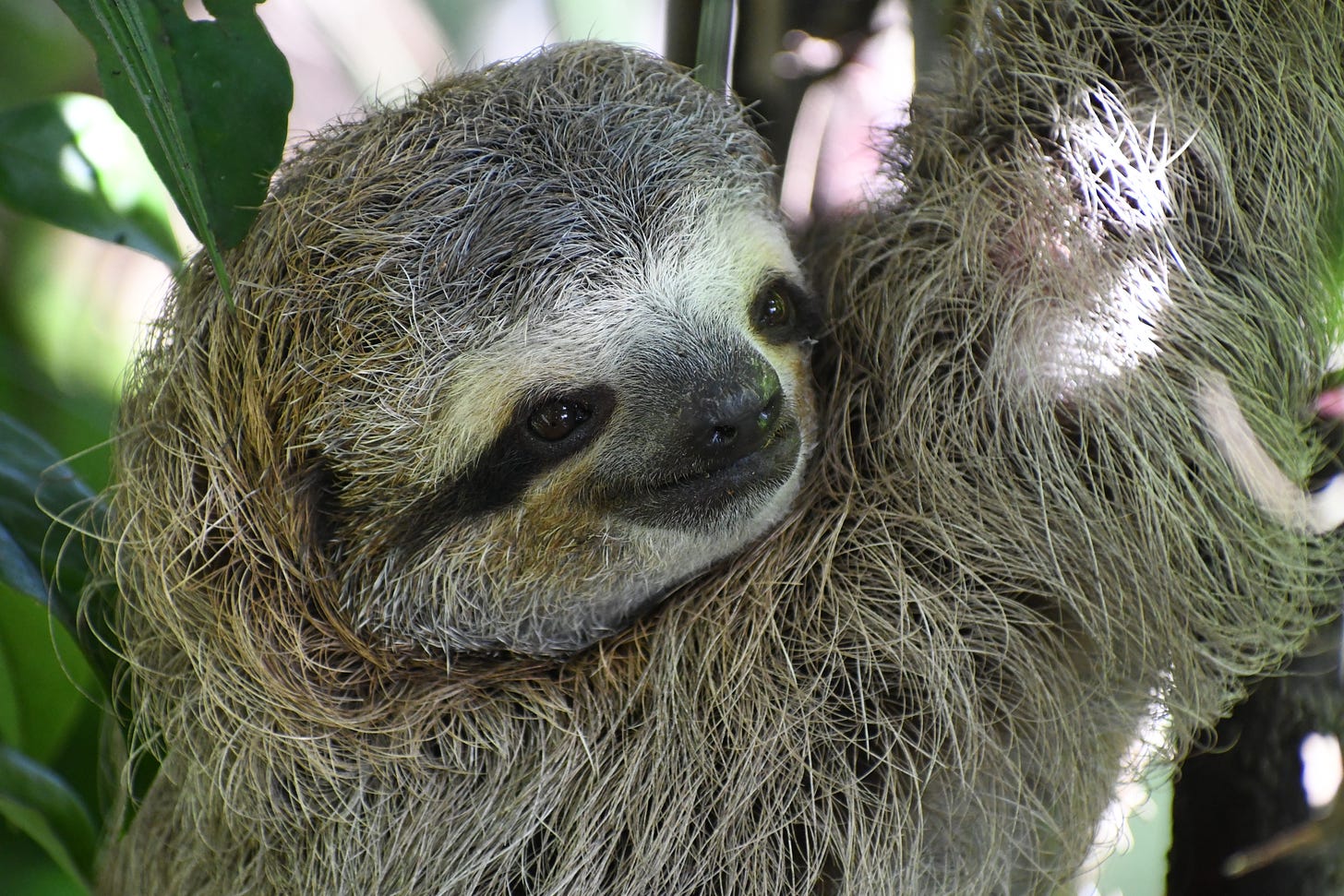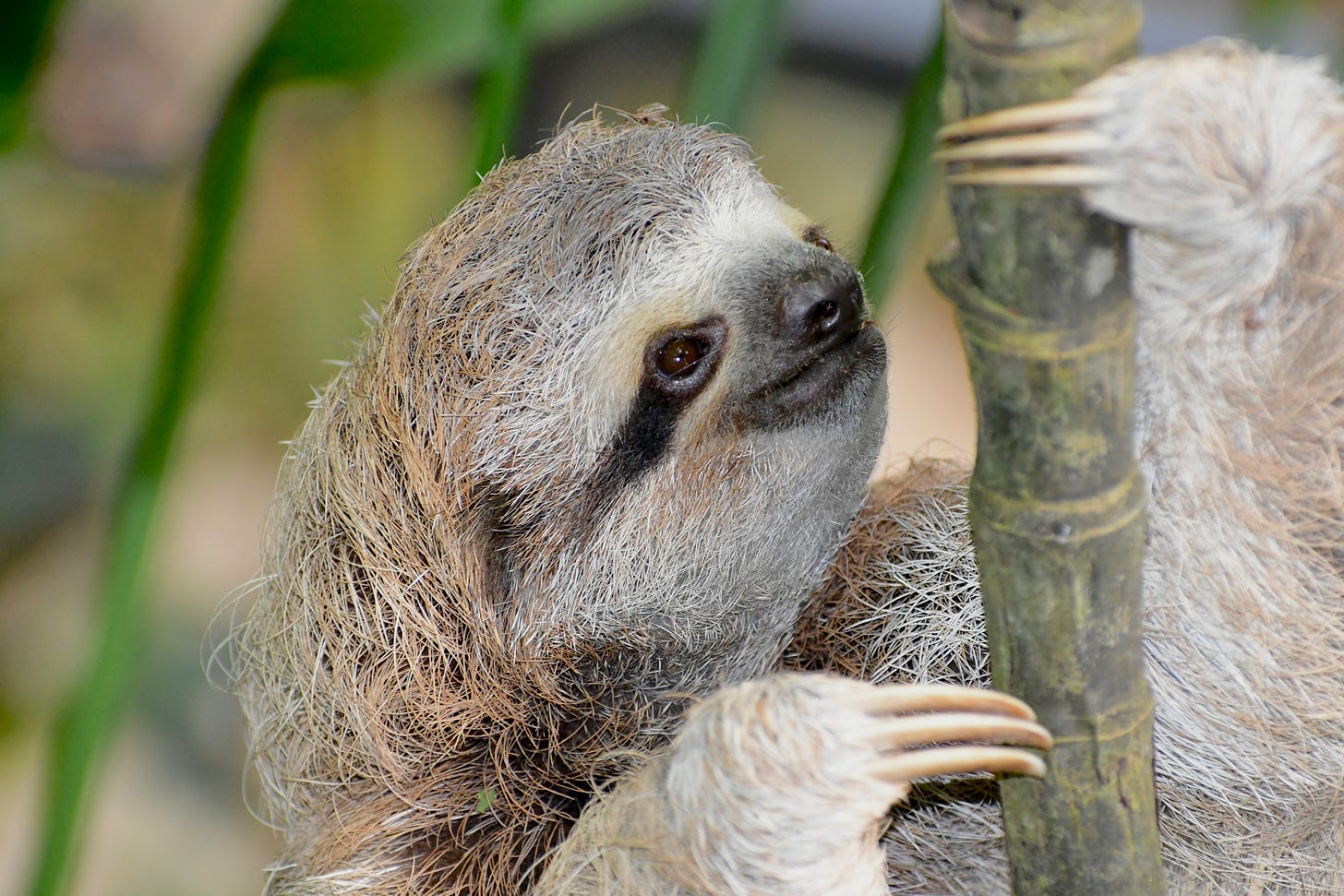Living in a jungle in Costa Rica, we certainly had some interesting neighbors! Neighbors who are there for a lifetime. Neighbors that would drop by unexpectedly. Sometimes ones that rarely leave. Or ones that depart without saying goodbye.
Linda was one of those neighbors. She fit all of those descriptions.
Linda was our sloth.
In the jungle, sloths were common but very hard to spot. I’m sure there were many who lived in our surrounding trees at any time. But never was one hanging around as close or as long as Linda.
When Flaco, our gardener, would spot a cool bug, snake, bird or monkey, he would tell me or the front desk staff so that we could show our guests. You come to Costa Rica to see cool animals, no? Yes!
In July 2019, Flaco spotted a sloth in the trees near our hotel dining room.
We named her Linda. Linda, in Spanish, means beautiful. So, Linda it was!
Even though sloths are solitary creatures, I think Linda liked being around us. Or maybe it was because we were surrounded by the cecropia trees whose leaves she liked to eat!
We’d see Linda up high. We’d see Linda down low. We’d see Linda in the morning. We’d see Linda at night.
We’d show her to guests. Linda was a big hit with the guests and staff alike. Hundreds of guests were able to enjoy her presence and return from their Costa Rican vacation telling friends and family that they saw a sloth up-close while on vacation!
You can see how close Linda is to the ground and Mark taking her picture. She was making her weekly trip down to use the ‘facilities’. © Marlo Leaman 2020
Note: If you are having trouble viewing the videos from your email, read in the Substack app or click here.
We’d watch her a lot! And as you might know, sloths don’t do much! In fact, the Spanish name for sloth is perezoso, meaning lazy.
In Costa Rica, there are both 2-toed and 3-toed sloths. In our location, the most common sloths were the 3-toed sloths. Sloths are exclusive to South and Central America, living in lowland rainforests.
If Linda hadn’t been seen in a few days, our hotel staff would all be on the lookout for her in the trees surrounding our hotel’s dining room. When she’d be found, we’d all be a little relieved. We liked her as our neighbor. She brought us joy daily! What a treasure it was to have her live so close and watch her.
A good neighbor – a found treasure. – Chinese Proverb
I was responsible for our social media accounts for the hotel. Between my personal social media accounts and the hotel’s social media accounts, I probably shared hundreds of video clips of Linda living in our surrounding trees. Can you understand why? This video of her slowly moving is just so cool!
In the early days of the Covid-19 pandemic, Costa Rica closed the borders, and we had to temporarily close the hotel (and lay off our employees). Mark and I remained living at the hotel, and with all the uncertainty in those early pandemic days, one thing remained steadfast – Linda’s presence.
Living at a hotel constantly surrounded by guests or staff, it felt strange to suddenly live at the hotel with no one around. Just me and Mark. (More on that time to come!) Every morning, I looked for Linda. She was the one thing that was constant in what felt like a very unstable time.
About 2 months into the pandemic, I returned to the U.S. fearing that if I didn’t leave when I could, I wouldn’t be able to get back to my family during this unprecedented time. I said “see you later” to Linda and left Costa Rica. Mark left Costa Rica a month later.
Linda also must have liked our constant presence because when we returned to Costa Rica 6 months later to finally reopen the hotel, Linda was gone.
Although we didn’t see Linda again, we did have other sloths appear from time to time, but none lived as close by or were as loyal as Linda.
We were really blessed for over a year to have her as our Costa Rican neighbor.
Linda certainly was a found treasure!
In case you are curious, here are some more fun facts about sloths!
Sloths are very slow-moving mammals. Sloths expend as little energy as possible. They stay in tree canopies hanging motionless, feeding and sleeping, about 15 to 20 hours every day. The fact that sloths have been around for over 65 million years shows that a slow-paced lifestyle can be a good survival strategy!
Maybe a good lesson for us from the sloth - slow down and live longer!
Sloths have the lowest metabolic rate of any mammal. It takes a sloth 30 days to digest a leaf.
Sloths have strange bathroom habits. The only time sloths venture down to the ground is to relieve themselves, which they do only once a week. They can lose up to a third of their body weight in one sitting!
Sloths are 3 times stronger than the average human. From the moment they are born sloths can lift their entire body weight upwards with just one arm. Special tendons in the sloth’s hands and feet allow them to hang upside down for long periods of time without wasting any energy. This unique mechanism is how sloths can sleep while hanging from a tree branch.
Sloths are blind in bright daylight. Sloths have a rare eye condition. They see poorly in dim light and are completely blind in bright daylight. They compensate for their poor vision by having a phenomenal sense of smell and a great spatial memory! Their bad eyesight also plays a role in the sloth’s daytime slowness.
Sloth fur is a living microcosm. Sloth hair provides a home to an entire ecosystem of invertebrates — some of which are found nowhere else on earth. A single sloth can host up to 950 moths and beetles within its fur at once. Cracks in their hair allow many different species of algae and fungi to grow which makes them appear green - an excellent camouflage!
Sloths are extremely vulnerable to deforestation. Most sloths are listed as ‘least concern’ on the threatened species list. But threats such as habitat loss and illegal wildlife trade do exist. Some sloth subpopulations, especially in Colombia and Brazil, are declining due to deforestation and degradation of their rainforest habitat. These tree-dwelling mammals rely on the health of tropical rainforests for food, shelter and space. So, as trees get cut down, the rainforest may shrink along with its inhabitants, one of them being the sloth.
Sloth facts:
https://www.wwf.org.uk/learn/fascinating-facts/sloth
https://www.ifaw.org/animals/sloths
https://slothconservation.org/10-incredible-facts-about-the-sloth/
I’d love for you to like this post or comment below if you think sloths are cool too!








Wow those facts are so interesting! Linda is beautiful and amazing 😍
I love you, Linda, wherever you are! Sloths live a long time, so I hope she's doing ok. When I went to Costa Rica last year I was psyched to see the sloths. They are so darn cute! They were even on the telephone lines, which is an unfortunate result of deforestation as you mentioned.